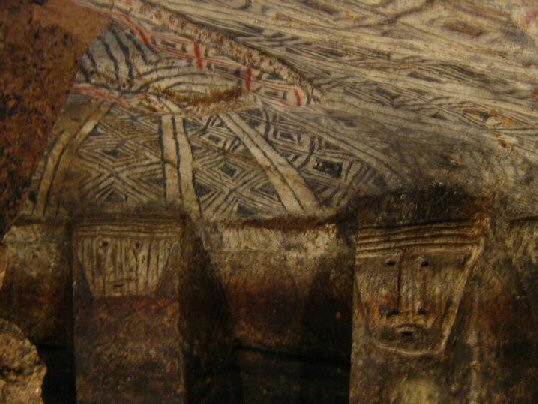|
Location:
Morales, Cauca,
Colombia. |
Grid Reference:
2.583� N. 76.033� W. |

 Tierradentro:
(Underground Hypogea).
Tierradentro:
(Underground Hypogea).
The area is well known for its numerous Pre-Columbian
Hypogea which were found in several excavations.
The typical hypogeum has an entry oriented towards
the west, a spiral staircase and a main chamber, usually 5-8m
below the surface, with several lesser chambers around, each one
containing a corpse. The walls are painted with geometric,
anthropomorphic and zoomorphic patterns in red, black and white. Some
statues and remains of pottery and fabrics can be seen, but are scarce due to
grave robbery before the hypogea were constituted as protected areas.
(Click
here for map)
|
Tierradentro ('Inside the Earth'): |
The area was once home
to a pre-Columbian culture which, for want of a better term is called
the San Agustin culture as similar pottery and art have been found at
both sites (1). Well over 50 tombs that have been discovered in the
area, all underground and originally filled in with earth. most of which
are accessible now; the government has excavated them and poured cement
around the original stairwells that lead down into the tombs to protect
them from erosion or other damage. Some have interior walls completely
painted in motifs of red (life), black (death), and white (hope of
making it to the next life). each one has a domed ceiling supported by
at least two columns.
The pre-Columbian culture that created this funeral
complex inhabited the area during the first millennium AD. The details in the sculptures, pictures and patterns are similar to
the San
Agust�n culture.
The Spaniards called the region Tierradentro,
suggested to be either because of the mountainous topography of the
area, which generates the sensation of being closed in, or perhaps
following the same theme, because of the numerous funerary Hypogea cut
from the rock, filled with funerary remains and soil, so that the
inhabitants were literally buried 'Dentro da Tierra' both within
the Hypogea and the mountains surrounding them.

Declared a Unesco Site of Importance in 1995.
The main sites in the Tierradentro
Archaeological Park:
There are five main areas in the park with
concentrations of hypogea and stone statues.
Alto de Segovia - This is the largest
area in the park, with an extension of approximately 13,000 square
meters. The 30 largest and deepest tombs are located in the Alto de
Segovia; some of them have beautiful high relief work.
Alto del Aguacate - Seventy tombs built side
by side in an artificially flattened hill are situated in this part of
the park. A combination of sculpture and painting in which circular
cavities were filled with paint was used to decorate the tombs.
Alto de San Andr�s - Six large hypogea were
discovered here, all of them with murals with geometrical designs in red
and black on a white background.
Alto del Duende - This site has four hypogea
with mural paintings.
El Tabl�n - Eleven statues in standing human
forms may be admired here. They have been classified in two groups:
small, plain statues that imitate naked humans, with very few
adornments, and masculine and feminine statues over two meters tall.
The Hypogea.
The vast number and size of the Hypogea in this area makes it unique
in pre-Columbian architecture. The underground spaces (Hypogea because
of the funerary aspect) were cut into the volcanic rock that form the
bedrock of the region. Not only are they unique for their architecture,
but also for the design and decoration inside them. Some of them are
carved up to nine metres deep
and are generally composed of a descent tunnel with ingenious snail stairs that
serve as the entry to the funerary chambers.

The tombs were all dug into the rock at varying depths, and some of them
are 25 feet down. The original steep, tall, stone steps provide access.
nobody has been able to determine how the people who made the tombs did
it: how they moved so much earth, how they carved the stone steps, how
they painted the tombs in the subterranean darkness.

This tomb was exposed when it was stripped bare by
'treasure hunters'

The insides of the Tierradentro hypogea are characterized by well-developed
pictorial work on the surfaces of the chamber murals, ceilings, and
columns. The motifs form complex geometric and figurative designs in
several colors: red, black, orange, grey, purple, and yellow.
Funerary Rituals of the Tierradentro Culture.
This culture is different from others in the region by having
two stages in its funerary rituals instead of one.
The primary or individual burial which took place in shallow shaft
graves with a small lateral chamber. The deceased was buried with
ceramic items, bead necklaces, grinding stones, and stone grinding
pestles, and was separated from the shaft by slabs that covered the
entrance to the chamber. This first burial did not last long. The
remains were soon taken out and carried someplace else.
The secondary or collective burial consisted of placing the
remains of rulers and priests in a ceramic urn with no cover and then
in a deeper grave called hypogeum.
|
Chronology:
Carbon dating of
funerary remains from the Hypogea show that the site was used from
600 to 900 AD.
(1)
|
(Other Underground Sites)
(Other
Pre-Columbian Sites)
|